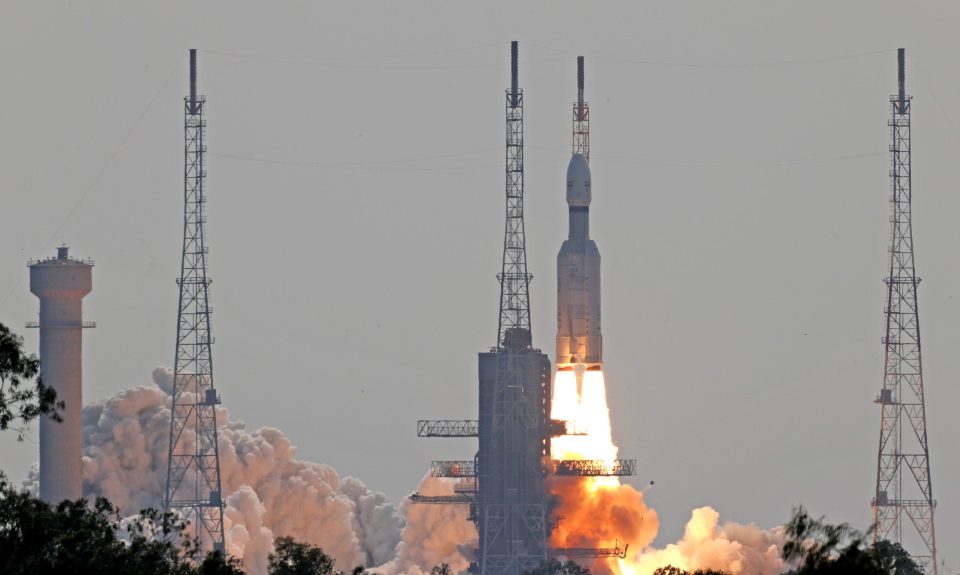
ISRO's LVM3 successfully deploys 36 satellites into designated orbits

ISRO’s LVM3 rocket flawlessly positioned 36 satellites belonging to the UK-based company OneWeb into their intended orbits, scripting history.
The 43.5-metre-tall rocket blasted off at prefixed time at 9 am today, from the second launch pad of Satish Dhawan Space Centre here, about 135 kms from Chennai, at the end of a 24.30-hour countdown.
LVM3-M3🚀/OneWeb 🛰 India-2 mission
is accomplished!All 36 OneWeb Gen-1 satellites injected into the intended orbits
In its 6th consecutive successful flight, LVM3 carried 5805 kg of payload to Low Earth Orbit@OneWeb @NSIL_India
— ISRO (@isro) March 26, 2023
This is the second dedicated mission for NewSpace India Ltd, the commercial arm of Indian Space Research Organisation. ISRO had signed an agreement with Network Access Associates Ltd, United Kingdom (OneWeb Group Company) for the launch of 72 satellites into Low-Earth orbits (LEO).
Also Read: ISRO’s LVM3 rocket carrying 36 satellites blasts off from Sriharikota
The first batch of 36 satellites of OneWeb Group company were launched on October 23, 2022 by ISRO.
OneWeb is a global communication network powered from space, enabling connectivity for governments and businesses.
Soon after the take-off, the rocket sequentially deployed the satellites into multiple orbits. While the first set of 16 satellites were injected, it was announced that the remaining satellites would be placed into the intended orbits.
ISRO said, “LVM3-M3/OneWeb India-2 mission is accomplished. All 36 OneWeb Gen-1 Satellites injected into the intended orbits.”
“In its sixth consecutive successful flight, LVM3 carried 5,805 kgs of payload to Low Earth Orbit,” the space agency said in its official social media account.
Also Read: Chandrayaan-3 and Aditya L1 missions may take off by mid-2023: ISRO chief
ISRO chairman S Somanath congratulated NSIL, ISRO and OneWeb for the successful launch of LVM3-M3-OneWeb India-2 Mission.
“As we know today the first 16 satellites of the series are already placed into the right orbit. And now it has gone into the far south of the Earth and we will be getting confirmation of the remaining spacecraft separation soon once the onboard storage data is acquired by our Indian ground stations.” he said addressing the scientists and guests at the Mission Control Centre.
The launch was the 18th for OneWeb Group company while for ISRO, it would be the second mission in 2023 after the successful launch of SSLV/D2-EOS07 mission undertaken in February.
“Till now, based on the observations, the vehicle has done extremely well, it went up to the right orbit and placed spacecraft at the right orbit and also with very minimal disturbances to it.” Somanath noted.
Also Read: ISRO successfully carries out controlled re-entry of aged satellite MT-1
Somanath expressed gratitude to NSIL for the support and for the confidence that OneWeb India team reposed in ISRO for building this rocket.
Union Minister Jitendra Singh lauded ISRO for Sundays successful launch.
“Proud to be associated with the department of space #ISRO at a time when India under PM @NarendraModi has emerged as the frontline Space Tech nation of the world,” he wrote on Twitter.
“Team ISRO adds yet another feather to its much-decorated hat. Successful launch of LVM3-M3/OneWeb India-2 MIssion”, the Union Minister of State (independent incharge) Science and Technology said.
With today’s mission, OneWeb would have 616 satellites in its fleet, which is more than enough to launch global services later this year.
This mission marks OneWebs second satellite deployment from India, highlighting the collaboration between the United Kingdom and Indian space industries, the company said.
Also Read: ISRO conducts key rocket engine test for Chandrayaan-3
Across India, OneWeb has aimed to bring secured solutions not only to enterprises but also to towns, villages, municipalities and schools, including the remotest areas in the country, it said.
The first set of satellite separation (comprising four of the 36 satellites) took place around 20 minutes after lift-off while the remaining satellites were deployed into their respective orbits, in phases later.
The satellites after being placed into the low-earth orbits would be divided among 12 planes at an altitude of about 1,200kms from Earths surface. Each plane would be separated at an altitude by 4 kms to prevent inter-plane collision, ISRO said.
This is the sixth flight of LVM3, which was earlier known as the Geosynchronous Satellite Launch Vehicle MkIII (GSLVMkIII) with a cryogenic upper stage. It had five consecutive missions, including the Chandrayaan-2.
(With agency inputs)

